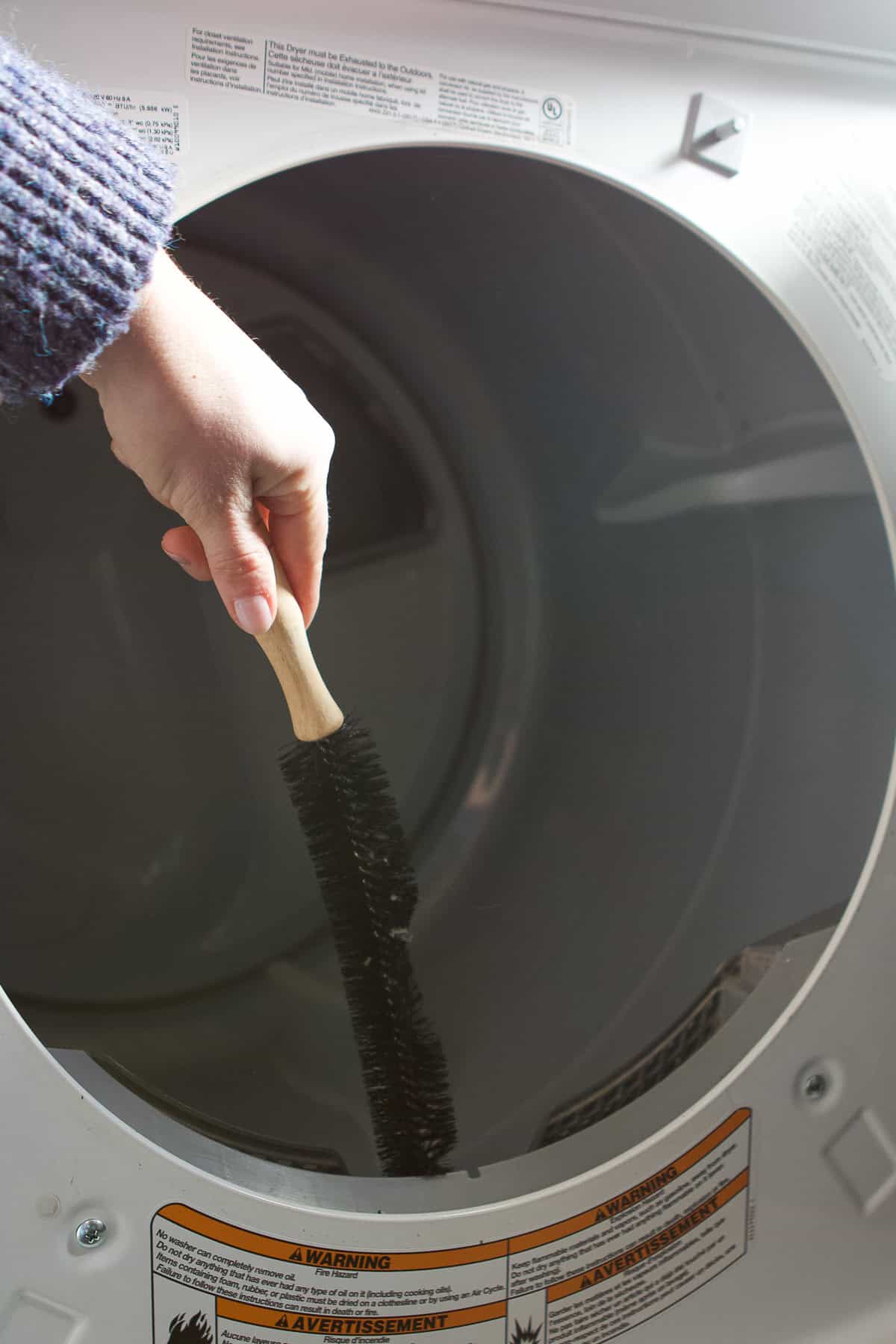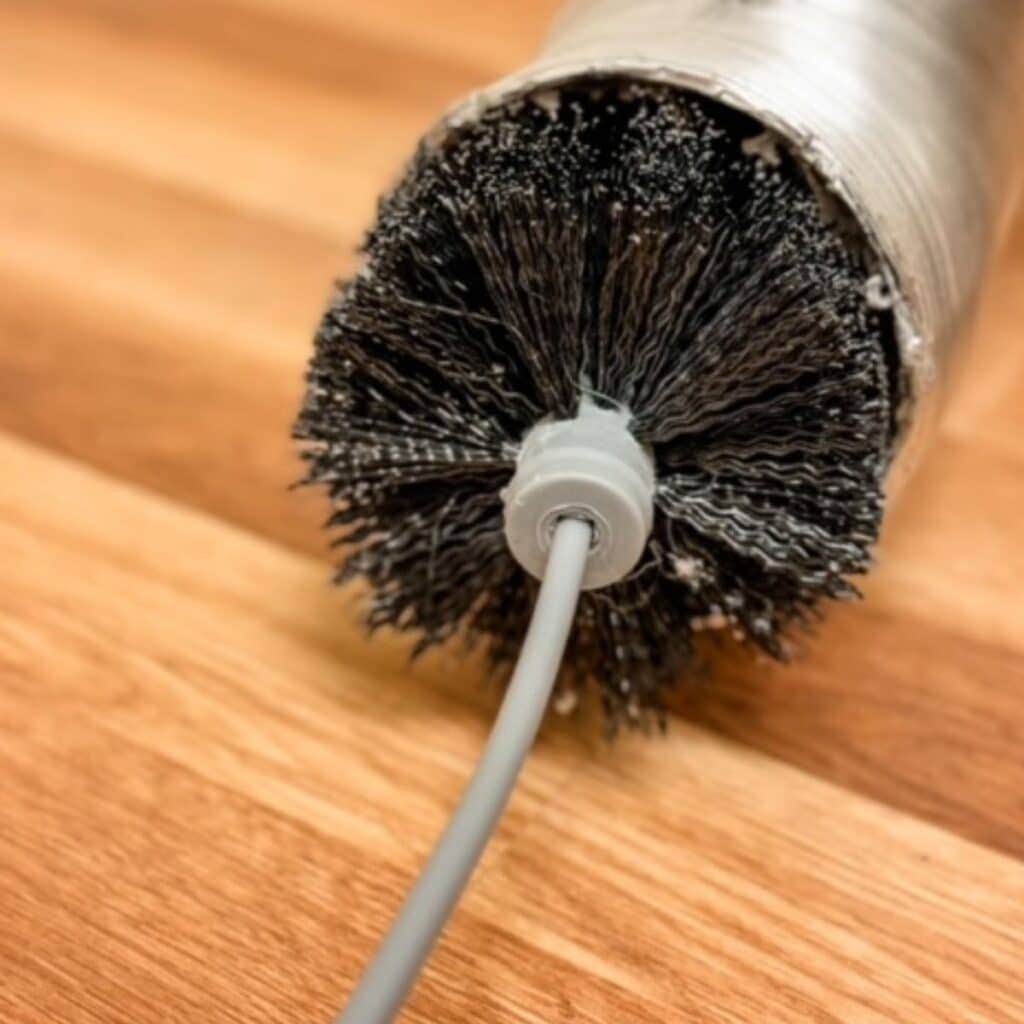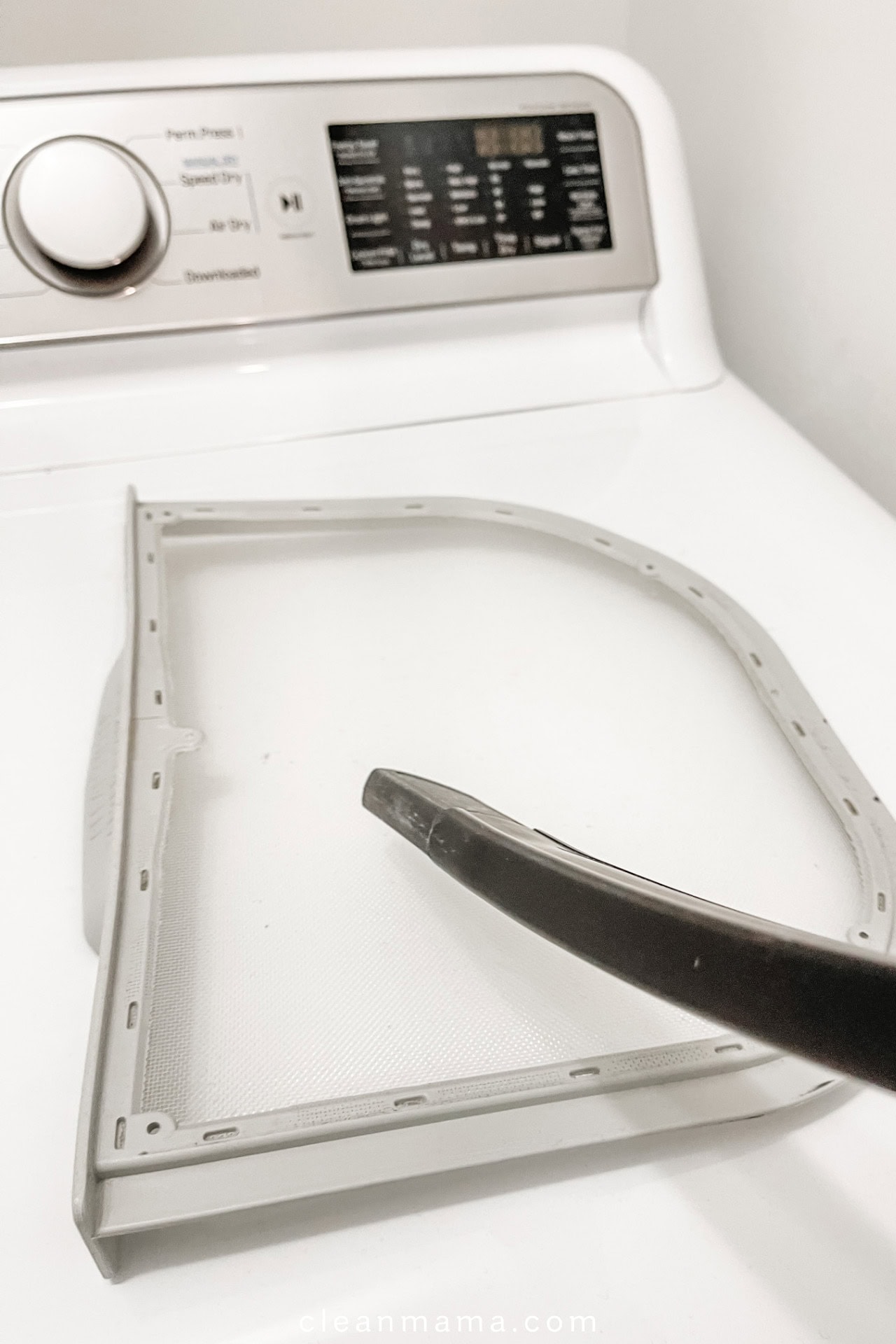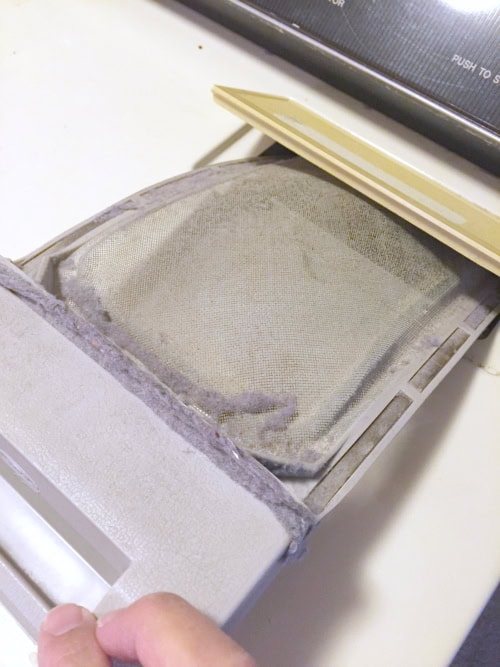Learning how to deep clean your dryer often becomes urgent when clothes take forever to dry or start smelling musty even after a hot cycle.
It’s frustrating to run the machine twice just to dry a single load, wasting both time and money with every extra cycle.
You might clean the lint trap, but still deal with heat issues, long drying times, or a strange burning smell that makes you uneasy.
Over time, lint, dust, and buildup collect in hidden areas like vents, ducts, and behind the drum where regular cleaning doesn’t reach.
Ignoring the problem too long can lead to damage or even create a fire risk that puts your home and family in danger.
Some people think the dryer is self-cleaning, but just like your washer or oven, it needs routine care to keep running safely and efficiently.
Trying to figure out what to clean, how often, or which tools to use can feel confusing without a clear guide.
This post may contain affiliate links. As an Amazon Associate and a participant in other affiliate programs, I earn a commission on qualifying purchases at no additional cost to you.

You might end up scrubbing random parts or skipping important areas, still leaving behind lint that blocks airflow and lowers performance.
The good news is, once you know how to deep clean your dryer properly, it works better, smells fresher, and feels safer to use.
You can even add small touches to the laundry area, like baskets, shelves, or wall hooks, to keep everything organized and looking nice.
Why You Should Deep Clean Your Dryer Regularly
Even if your dryer looks clean on the outside, lint and dust are building up inside the machine every time you run a load.
This buildup blocks airflow, traps heat, and forces the machine to work harder, shortening its life and wasting energy over time.
A dirty dryer can leave clothes damp or smelling burnt, even if you’re using the right settings and drying time for each load.
Lint also collects around the drum, in the lint trap housing, and especially in the vent line that leads to the outside wall.
When too much lint piles up, it becomes a serious fire hazard that many people don’t notice until it’s too late.
If your machine is hot to the touch or you smell something odd while drying, that’s a warning sign of lint buildup.
Cleaning just the lint screen isn’t enough. You need to go deeper to keep your dryer safe and performing like it should.
Regular deep cleaning also helps protect your clothes from heat damage and cuts down on how often you need to iron or rewash them.
With a clean dryer, your laundry routine becomes faster, easier, and a lot more dependable from one load to the next.
Taking a little time to deep clean your dryer now can prevent bigger problems, save energy, and keep your home safe year-round.
How Often Should You Clean Your Dryer?
You should empty the lint trap after every load, but that’s just the first step toward keeping your dryer running at its best.
Plan to deep clean the machine at least once every three to six months, depending on how often you use it each week.
If you have a large household or use your dryer daily, you may need to clean it more often to prevent buildup and fire risk.
Check behind and underneath the unit quarterly to clear out dust and lint that escape from the drum and vents over time.
The outside vent flap should be inspected every month to make sure air is flowing freely and nothing is blocking the path.
You should also clean the vent hose and duct line every six months, especially if the dryer is taking longer than usual to finish.
If clothes feel extra hot or have a strange smell, that’s another clue that your dryer needs a deep cleaning right away.
Any humming, thumping, or poor airflow could also mean lint has clogged an area that you can’t see without moving the machine.
Create a simple checklist so you don’t forget, and pair the task with other seasonal chores like changing filters or washing windows.
A regular cleaning schedule keeps your dryer in good shape and helps avoid unexpected problems that slow down your entire laundry process.

What You’ll Need To Deep Clean Your Dryer
To deep clean your dryer properly, you only need a few basic supplies that help reach lint, dust, and grime in hard-to-access places.
These tools are safe to use and give you better results without damaging the machine or making the job harder than it needs to be.
- Vacuum with hose attachment
- Dryer lint brush or long-handled brush
- Screwdriver
- Microfiber cloths
- Warm soapy water
- Old toothbrush
- Baking soda and vinegar
- Flashlight
- Dryer vent cleaning kit
- Step stool
Tap Photos To Shop
Would you like to save this post?
Step-by-Step: How To Deep Clean Your Dryer
Deep cleaning your dryer doesn’t take long, but it makes a big difference in how well it runs and how safe it is to use.
These steps will help you clear out lint, reduce fire risk, and make your dryer work more efficiently with each load of laundry.
1. Unplug the dryer and pull it away from the wall
Start by turning off the power and unplugging the dryer completely for safety before doing any cleaning or moving. Pull it out gently to give yourself space to clean behind and underneath, where dust and lint often build up unnoticed. Have a flashlight nearby to help you see around corners and check spots that are usually hidden during daily use.
2. Remove the lint trap and clean the housing
Take out the lint screen and wash it with warm, soapy water to remove dryer sheet residue that blocks airflow. Use a lint brush or vacuum hose to reach deep inside the slot where the trap sits, pulling out loose debris and buildup. Let the screen dry fully before placing it back to avoid moisture collecting inside the vent path.
3. Vacuum behind and underneath the dryer
Use the hose attachment to suck up lint, dust, and pet hair from the floor, wall, and base of the machine. Pay close attention to corners and the area around the dryer’s exhaust hose, where lint gathers and poses a fire risk. Wipe the floor with a damp cloth to catch anything the vacuum missed and leave the area fresh.
4. Detach and clean the dryer vent hose
Loosen the clamp that holds the vent hose to the dryer, then remove it and shake out any loose lint. Use a vent brush or vacuum to clean inside both the hose and the wall vent until everything feels smooth and clear. Reattach the hose tightly to make sure air flows freely without leaks that waste energy or cause heat buildup.

5. Clean the drum and interior surfaces
Wipe down the inside of the drum with a damp cloth to remove residue left from softeners, dryer sheets, or general use. Check around the drum edges, seal, and door for lint or dust that could transfer back to your clean clothes. Use an old toothbrush to scrub inside grooves and crevices where buildup hides and regular wiping doesn’t reach.
6. Inspect the vent flap outside
Go outside and check the flap where the dryer vents to make sure it opens easily and isn’t blocked by leaves or debris. If lint is stuck in the flap or screen, remove it gently so air can pass through without resistance. This step is important for airflow and also stops pests from nesting inside the vent opening.
7. Wipe down the exterior and control panel
Spray a cloth lightly with soapy water and wipe the top, sides, and front of the dryer to remove dust and fingerprints. Use a toothbrush around the buttons or knobs to clear out lint that collects where you push or turn controls. Finish by drying the surface with a clean towel so everything looks fresh and polished.
8. Plug in the dryer and push it back into place
After everything’s cleaned and dry, plug the machine back in and slide it carefully into its normal position. Make sure the vent hose is straight and not crushed so air can move through without resistance. Double-check that the flap outside is working properly before starting your next load.

Extra Tips To Keep Your Dryer Clean and Safe Year-Round
Check the lint trap after every load and remove debris right away to help airflow and lower the risk of lint catching fire.
Wipe the drum and door with a damp cloth weekly to stop buildup from transferring onto your clothes or causing strange smells.
Avoid using too many dryer sheets since they leave behind residue that clogs vents and sticks to sensors inside the machine.
Hang bulky items like blankets or comforters when possible to cut down on dryer use and prevent heat strain on the unit.
Vacuum around and behind your dryer monthly to catch dust that slips through cracks and collects along the baseboards.
Leave the dryer door open after each use to let moisture escape and keep the inside smelling clean between loads.
Clean the vent hose every six months or more often if drying time gets longer or the machine feels hotter than normal.
Use a dryer vent cleaning kit to clear long or curvy vent lines that are hard to reach with a regular vacuum.
Make sure the outside vent flap moves freely and isn’t stuck shut or blocked by dirt, leaves, or snow.
Keep your laundry area tidy with wall shelves, hanging baskets, or labeled bins so dryer tools and supplies are easy to find.

Frequently Asked Questions
Lint and dust will build up, causing longer dry times, overheating, or even fire hazards that put your home and family at risk. Skipping regular cleaning also makes the dryer work harder, raising your energy bills and wearing out the machine faster than normal use.
Remove it after every load, pull off visible lint, then wash with soapy water monthly to remove buildup from dryer sheets and softeners. Let it dry completely before placing it back, so moisture doesn’t create a sticky surface that attracts more lint and dust.
Lint may block airflow in the vent system if clothes take too long to dry or the dryer feels hotter than usual. Other signs include a burning smell, a vent flap that won’t open, or lint blowing around outside where the dryer vents.
Yes, the outside vent flap should open easily and stay clear so air can escape without backing up into the machine or ductwork. Blocked outside vents slow drying times, raise heat levels, and increase fire risk, so check them monthly for safety and proper airflow.

Many people overlook dryer care until something breaks or a bad smell makes them question how clean the machine really is.
Knowing how to deep clean your dryer helps it run safely, dry clothes faster, and smell fresher after every load you run.
It also saves energy, lowers fire risk, and helps your laundry routine run smoother without annoying slowdowns or overheating issues.
Add small decor like baskets, trays, or wall hooks to your laundry space to store cleaning tools and make the area feel more inviting.
A clean dryer works better, looks nicer, and gives you peace of mind every time you push that start button.









